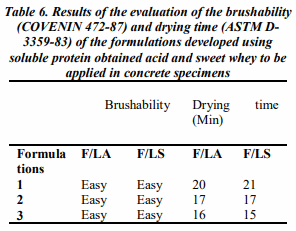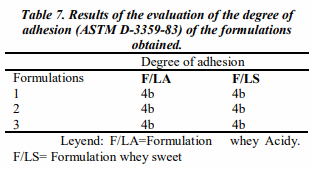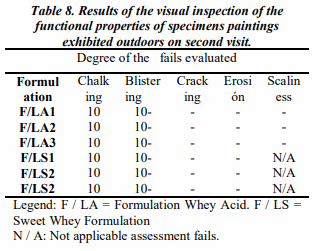Materials and methods
Characterization of whey: To determine the physicochemical and microbiological properties of bovine whey, collecting samples of cow's milk from the integral "José Leonardo Chirinos" (UniasUNEFM) Socialist Unity Township Agroecológica Hill, State of Falcon, Venezuela was held. We proceeded to the production of whey in the laboratory, using lactic acid and milk clotting enzyme. The whey was characterized physicochemical and microbiological, attached to the procedures established in COVENIN 903-93 standards set for raw milk, applied by analogy to a milk derivative. The parameters determined and the specific standards used for each case were: pH (Corning pH meter 220); Relative density and temperature (COVENIN 367-82); Titratable acidity; (COVENIN 658-86); Chlorides (COVENIN 369-82); Fat Gerber method; (COVENIN 931-82); Moisture (COVENIN 1077-1997); Numbering mesophilic aerobic bacteria (COVENIN 902-78); Numbering Yeast and Mold (COVENIN 1337-1378).
Formulation and Development of craft paints: characterized from whey, whey soluble protein was obtained by separation by heating the serum between 75 and 90 ° C in acid (10% citric acid) medium, to reach pH isoelectric precipitate of albumin and globulin as white floc (Dilanjan, 1970). It was dried at 60 ° C, milled and ground to the desired appearance. Equipment used: digital pH meter, thermometer, stove, Ball Mill Restch brand, model PM10. Using the procedure reported by Carbonell, 2009, selected for the production of paint materials were: Calcium Carbonate, Carboxy Methyl Cellulose (CMC), iron oxide, clay, Hydrogen Peroxide and Water; were weighed into a mechanical mixer until a homogeneous mix. The paintings are to transfer different containers and stored, the behavior of the paintings was observed suboptimal considering those formulations in which there was microbial growth in the first 24 hours of storage.
Evaluation of the physicochemical and functional characteristics of paints formulated.
The final product was evaluated to understand their physicochemical properties by ASTM, COVENIN. Certain parameters and rules used for each were: Cupzahn Viscosity (ASTM D-3794); Percent solids, (ASTM D-1644), brushability, (COVENIN 472-87); Drying time (ASTM D-1640); Adhesion (ASTM D3359-83). The paint was applied on concrete specimens and exposed in an urban environment of the city of Santa Ana de Coro, Falcon State, Venezuela, which has a semi-arid climate and high temperatures; indoor and outdoor functional properties were evaluated through ASTM standard for determining impairment of painting and photography by visual inspection the following characteristics were evaluated: degree of blistering (ASTM D-714); Chalking grade (ASTM D-659); Degree of erosion, (ASTM-662); Degree of cracking (ASTM D-661); Level scaling, (ASTM-714)
Results and discussion
Table 1 shows that the acid whey showed pH (actual acidity) of 5.9 while the sweet whey showed pH 6.5, being this close to neutrality, these values show that the serum obtained by coagulation lactic acid is more than that obtained by enzymatic coagulation, because this is given by lactose fermentation, by action of lactic acid producing microorganisms by lowering the pH to reach the isoelectric point.
The two types of whey have equal specific gravity of 1.025 g / cm3, very close to the density of water this is because these liquids are composed mostly water. The fat column was observed for 2.1% and 4.2% acid whey (Guerrero et al., 2010). The amount of chloride was 0.147 and 0.143%, respectively, when its value was expected in the range of 0.07 to 0.11%, according to values set in the COVENIN 903-93 applied by analogy, indicating a high amount of chlorides in serum samples; coinciding with Bracho, 2013 who indicated that chlorides milk whey and therefore are high on production systems in the coastal belt of Venezuela-Falcón state, because of its proximity to coastal aquifers. As the amount of moisture that each hold up to 93.571% for acid whey and 92.808% for sweet whey, this parameter like density are closely related to the composition of whey is shown in Table 1 in which water plays a key role.

The Table 2 reported the titratable acidity in the acid whey was 19,333mL 0.1N NaOH / 100 mL and the sweet whey 10,667 mL 0.1 N NaOH / 100 mL, the latter having a low acidity in relation to its production process, as can be seen in Table 2. the mean percentage of total solids is from 6.429% to 7.192% acid for mild, content of total solids in the acid whey is within the normal range (6.44%) of the byproduct, sweet whey has a greater amount of total solids compared with the acid whey, as during cheese making as much solids present is removed, may be due to any of the coagulation process renders the soluble protein flocculated in a more than the other. Note that the total solids are represented by the remaining fat, soluble proteins in colloidal suspension, lactose, vitamins, salts and other inorganic and organic compounds in solution (Bracho 2013).

The results of the microbiological characterization of the whey acidic and sweet Table 3, show an aerobic mesophilic bacteria content increased> 300 CFU / 100mL which classifies the two types of whey as a category A, as they are below the maximum allowed (5x105 CFU / mL) by Venezuelan law 903-93 COVENIN applied by analogy. Also, the presence of molds and yeasts in both types of whey was high, which is characteristic (Frazier, 1980). This is due to the fermentation process and also because the whey is an excellent growth medium for bacteria.

As shown in Table 4, only the proportions of protein and clay were varied, the amount of clay varied along with protein because of its usefulness in the formula, this is responsible for making compatible protein water to achieve form a homogeneous mixture, these formulations were also subjected to quizzes on the carton and on the test substrate, these positive results because in the first instance the paintings showed a matte finish, aged color and good coverage, also showed no problems such as cracking, chalking, detachment from the substrate and reproduction of microbial organisms. Note that these formulations were developed by varying the type of soluble protein, that is, three (3) were made formulations with protein from whey acid and three (3) of the sweet whey, then analyzes followed COVENIN and ASTM standards for paintings.

In Table 5, the percentage of solids contained in each formulation are presented. This increased density as compared to the amount of protein samples possessing in its composition. On the amount of solids in paints, Bustamante (2008) stated that these are incremented according to the amount of solid matter (binder, pigment, filler) which they contain, this was reflected in that formulations with a higher content of protein, a higher percentage of solids, taking into account that according to the evaluation method of this property the percent solids of paints formulated was represented by: soluble protein, clay, lime, part of the pigment and the whole filler or filler material possessing in its composition due to using the entire procedure for the water and hydrogen peroxide liquid is evaporated by subjecting the samples to warming.
As the viscosity favorable values were observed in all cases, because this property has extensive relationship with the final features set at work, the formulations had acceptable viscosities as they were expected intermediate values, taking into account reported by Alfaro (2012) who enunciated that very low viscosity values could cause serious problems for the paint, either on the packaging (sedimentation, phase separation) or during application.

Reporting the results of the test brushability was performed using this test paint was applied to a previously selected substrate and arranged to determine the ease of application of paint in table 6, in this analysis, no difference was observed higher among the results provided by a formulation to another, usually presented as an easy brushability difficulty or skid resistance of the brush was negligible for all cases, which is why it is said that you have easy brushability. Formulations took longer to dry were the first of each case. Thus becoming the order of the drying time according to the formulations, Ts1> TS.2> TS.3. Thus, it was observed that the drying time was improved as the percentage of added soluble protein was increased as the formulation became more consistent resulting in greater hardness and therefore provide a higher yield, coinciding in this with Bustamante (2008 ) who states that the drying time decreases as the percentage of solids and filler in paint increases.

In Table 7, the results obtained in the study of the adhesion of the paint to the substrate where they were applied are presented. The adherence of the formulations according to the classification by ASTM method were 4b observation for all formulations, displayed in the intersections of the cuts, small fragments of paint came off, the cut area is not significantly affected more than 5 %, this value is considered acceptable and is said to meet the quality standards and adherence as they accepted standards for commercial grade paint is 4b and 5b where the edges are completely smooth and none of the corners of the grid was detached and grade 4b which is described above and by the developed formulations.

The specimens were exposed to display the deterioration in time during the inspection, which was performed by visits with intervals of twenty (20) days. On the first visit records the initial conditions were taken. At the second hearing, twenty (20) days loss of color was observed in the three samples from the outside while exposed inside suffered no change, deterioration in the paintings exposed to weathering is caused because these are UV directly and they are subjected to sun and heat plus humidity, however, as reflected in Table 8, it is not remarkable in them the chalked that as Giudice and Pereyra (2009) suggests this is of great importance as this involves degradation of material comprising the paint by the action of the UV fraction of solar light. Taking into account the observations stated that the formulations presented chalking grade 10 according to the pattern provided by the ASTM D-659, as to the degree of blistering was negligible and was graded on a numerical scale according to ASTM D -714, with number 10 in size of ampoules, representing a surface without blisters. Cracking and erosion were no notable flaws like the scaling, cracking the case of no breaks of any kind were observed on the painted surface based on patterns including ASTM D-661 standard for evaluation of degree of cracking. As erosion and scaling, the first was not noticeable as I do not find the substrate was observed by paint wear so he was not given any qualification as it is set out in ASTM D-662, the last fault was assessed only paintings displayed outdoors as set the standard ASTM-772, in which the separation of fragments of the paint film is evaluated; by this method was learned that the painted specimens showed no scaliness ..
In the third and last visit it was observed that the formulations exhibited abroad continued to lose color intensity while maintaining its other characteristics, with no presence of chalking, blistering, erosion, cracking and scaling, which suggests that this type of paintings is not optimal for outdoor environments as metal oxides used as colorants not resist UV rays. Meanwhile, formulations exposed indoors did not suffer any changes and may consider that the deterioration was zero in the medium term observation, why we can say that the best craft paints are formulated to be applied in environments interior, being of low or no toxicity due to its constituent components.
Conclusions
Through the determination of physico-chemical and microbiological parameters of the two types of whey, using COVENIN 903-93 standards was verified that both show variability of each other according to their parameters, due to the different processes of obtaining, in turn through the high contaminant microbiological characteristics was found that this level has reason to cause severe environmental damage. Evaluations of the physicochemical properties of each of the developed formulations showed acceptable values among which an alkaline pH and total solids content between 8.4 and 9.25% for the paintings in their formulation containing soluble protein obtained whey and 5.88 and 7, 97% for the rest of the formulations. The brushability paints to be applied to the substrate was easy, they offered no resistance to sliding brush, drying time in paints ranged between 16 and 21 minutes when exposed specimens with the formulations previously applied presented an optimal behavior evaluated regarding their functional properties, due to the occurrence of: chalking, cracking, erosion, blistering and scaling were insignificant.
Whey disposal of the dairy industry, is a pollution residue to the environment, however, an alternative feedstock in the manufacture of paints ecological benefits such as low odor, low cost, with solvents such as water, and used as recharge clay material (non-metallic mineral) and natural oxides, which allow to develop a commercial paint that can be put into practice in any enterprising business in rural or peri-urban.
This article was originally published in International Journal of Engineering Sciences & Research Technology. The author shared it for its reproduction on this site.



















